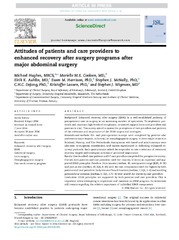| dc.contributor.advisor | Lassen, Kristoffer | |
| dc.contributor.author | Aahlin, Eirik Kjus | |
| dc.date.accessioned | 2016-10-12T05:58:28Z | |
| dc.date.available | 2016-10-12T05:58:28Z | |
| dc.date.issued | 2016-10-21 | |
| dc.description.abstract | Background: Patients with colorectal malignancies have benefited from major improvements in surgical technique and perioperative care during the last decades. These improvements have contributed to fast recovery and high survival rates. In contrast, patients with upper abdominal malignant disease often experience delayed recovery and long-standing functional impairment. Postoperative complications are frequent and the prognosis is often poor. Only a small fraction of patients will survive for five years or more after surgery. Delayed recovery, postoperative morbidity and poor prognosis will naturally affect patients’ health-related quality of life (HRQOL). Patients with upper abdominal malignancies are often weakened by cachexia and sarcopenia (low relative amount of skeletal muscle tissue) preoperatively. Aim - To explore predictors and determinants for recovery and survival after upper abdominal surgery. - To explore how patients and dedicated professionals define recovery. - To explore new and old indicators of risk and prognosis with emphasis on methods to assess cachexia and sarcopenia. - To explore correlations between postoperative morbidity, HRQOL and overall survival after major upper abdominal surgery. Results and conclusions Recovery of mobility and GI function are considered the most important target of convalescence after surgery. The traditional global indicators of poor prognosis after surgery, preoperative weight loss and abnormal serum-albumin, are still valid today. There is a close correlation between functional impairment and prognosis after major upper abdominal surgery. Tissue loss during surgical and oncological treatment for upper abdominal cancer can be evaluated through routine CT examinations. Preoperative low muscularity is independently associated with poor prognosis after resection for gastric adenocarcinoma. However, preoperative body composition indices do not seem to be global indicators of poor prognosis as importance and cut-offs seem to vary with different diseases. Postoperative morbidity is associated with poor long-term survival after major upper abdominal cancer surgery. | en_US |
| dc.description.doctoraltype | ph.d. | en_US |
| dc.description.popularabstract | Kirurgi for kreftsvulster i øvre buk (spiserør, magesekk og bukspyttkjertel) er ofte forbundet med mye komplikasjoner, høy funksjonsnedsettelse og dårlig prognose. Prognosen etter slik kreftkirurgi har tradisjonelt vært basert på svulst størrelse og omfang, men forskning tyder på at også mange andre faktorer er viktige.
Vi har analysert hvordan vekttap, proteinnivå, muskulatur, komplikasjoner og livskvalitet påvirker prognosen etter kreftkirurgi i øvre buk.
Vi har funnet ut at vekttap og lite muskulatur før operasjon er assosiert med dårligere prognose. Pasienter som oppgir dårligere livskvalitet etter operasjon synes også å ha dårligere prognose. Komplikasjoner etter en operasjon er forbundet med dårligere prognose, også på lang sikt.
Disse funnene er i samsvar med andre internasjonale resultater og kan på sikt bidra til bedre oppfølging av pasienter før og etter kreftoperasjoner i øvre buk. Dette kan kanskje bidra til å bedre prognosen ved kreftsykdom i øvre buk. | en_US |
| dc.identifier.uri | https://hdl.handle.net/10037/9837 | |
| dc.language.iso | eng | en_US |
| dc.publisher | UiT The Arctic University of Norway | en_US |
| dc.publisher | UiT Norges arktiske universitet | en_US |
| dc.rights.accessRights | openAccess | |
| dc.rights.holder | Copyright 2016 The Author(s) | |
| dc.rights.uri | https://creativecommons.org/licenses/by-nc-sa/3.0 | en_US |
| dc.rights | Attribution-NonCommercial-ShareAlike 3.0 Unported (CC BY-NC-SA 3.0) | en_US |
| dc.subject | VDP::Medisinske Fag: 700::Klinisk medisinske fag: 750::Gasteroenterologisk kirurgi: 781 | en_US |
| dc.subject | VDP::Medical disciplines: 700::Clinical medical disciplines: 750::Gastroscopic surgery: 781 | en_US |
| dc.title | Predictors and determinants for recovery and survival after upper abdominal surgery | en_US |
| dc.type | Doctoral thesis | en_US |
| dc.type | Doktorgradsavhandling | en_US |


 English
English norsk
norsk






